| Return to main page |
The presentation focused on the history of Przemysl: 'From the Middle Ages, this was an area where three groups intermingled: first Western Slavs, who were overwhelmingly Roman Catholic, second Eastern Slavs, overwhelmingly Orthodox, then later Greek Catholic, and third Jews. At the beginning of the twentieth century these three groups were of roughly equal strength in the city. Intermarriage between the first two was common. In such mixed marriages it was common to observe both religious calendars. Children followed the religion of the same-sex parent. Many people were fully bilingual, and many cultural phenomena were a genuine synthesis of eastern and western traditions: for instance, some of the carols sung at Christmas could not be allocated unambiguously to one side or the other.
This peaceful coexistence of different traditions began to come under pressure from rival nationalist movements in the closing decades of the Austro-Hungarian Empire. As early as 1875 some Jews in Przemysl established an Association for Settlement in the Land of Israel, a forerunner of Zionism. In the violence that marked that Empire's collapse, in the aftermath of the First World War, Przemysl became part of the new independent Poland. Nationalist tensions continued to rise, as Ukrainians in Poland experienced strong discrimination. In the harsh economic climate of the 1930s, both groups turned against the Jews, e.g. by boycotting their shops. Polish nationalists erected a monument to some schoolboys who had lost their lives in the fighting of 1919.
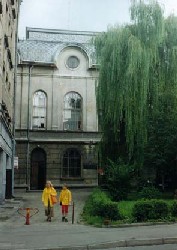 |
 |
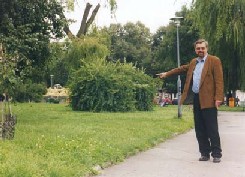 |
Figure 65: Synagogues of Przemysl: (i) currently the city library, (ii)
overshadowed by a new gas station, (iii) site of the most celebrated central
synagogue, destroyed by the Germans in 1941 and never rebuilt.
In September 1939 the River San became the border between the occupying powers. The Germans took the western part of the city and the Red Army the older, eastern part. Given the deterioration of Polish-Ukrainian relations, it was not difficult for the occupiers to enlist local Ukrainians as administrators and policemen.'
Tom whispered to Ania: 'It's like segmentary systems in Africa. You remember, 'the enemy of my enemy is my friend'.'
'The monument to the schoolboys was torn down on German orders. After they attacked the Soviet Union the whole city passed under German control. The Jews were deported to the camps. There is almost no trace of them left, though the building you are in right now used to be the largest of their numerous places of worship.
Eventually the Red Army returned to conquer, but that was not the end of the violence for us. In the mountains which you have visited this week, small groups of Ukrainian nationalists continued their struggle. The new Polish authorities decided that the only way to deal with this 'terrorist' problem was to eliminate all remaining Eastern Slavs from this region. They were relocated to the lands which Poland obtained in the north and west, which had formerly belonged to Germany. At about the same time the Greek Catholic Church was dissolved; its property was handed over to other churches or used by the state, and its last bishops died in Soviet camps.
So, in less than a decade the city lost two of its three ethnic communities: only Roman Catholic Poles were left. Actually, not quite all of the Ukrainians were deported: those who were married to Poles, or who managed to persuade a Roman Catholic priest to register them as his parishioners, were able to avoid this fate. Very cautiously, following the political thaw of 1956 some of these people dared to declare their minority status. A Ukrainian Club was formed, under the close supervision of the communist authorities, of course, and a Greek Catholic parish took shape under the umbrella of the Roman Catholic church, which gave the minority use of a central church, the so-called Garrison church. The later years of communism witnessed a steady trickle of Ukrainians back to their home region. Przemysl was a natural place to seek accommodation and work for those whose homes elsewhere had either been destroyed or reallocated to Poles. However, so long as communism lasted all this was extremely discreet. The Ukrainian minority was almost invisible in the life of the city.
This changed with the end of communism. The Greek Catholics sought
and obtained recognition. The Pope appointed a new Greek Catholic bishop
to the see of Przemysl. This bishop applied for the restitution of the
so-called Carmelite church, which had been the Greek Catholic cathedral
until their suppression in 1946. This opened up a series of conflicts that
lasted for most of the 1990s. Polish nationalists argued that the Carmelite
church had, at its foundation in the seventeenth century, been a Roman
Catholic establishment, and that there were no good grounds for handing
it over to the Ukrainians. The conflict came to a head in 1991 when Pope
John Paul II himself visited this city. Direct action by the Polish nationalists
prevented him from fulfilling his plan to transfer the Carmelite church
to the minority community. Instead he made a gift to them of the Garrison
church, which they had been using on an unofficial basis ever since 1956.
The Greek Catholics have accepted this offer, even though the whole affair
was a bitter disappointment for the minority. They have carried out significant
alterations to the building to make it more suitable for their rite, much
to the anger of the Polish nationalists, who see this as a part of Polish
culture that has now been lost to the minority. They have taken their revenge,
so to speak, by tearing down the tower of the Carmelite church, which was
added by the Greek Catholics when they were using this building in the
nineteenth century, and replacing it with a slender spire which they consider
to be more in keeping with their western, Polish traditions.
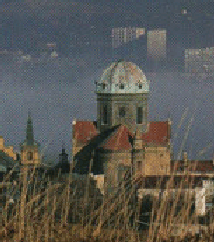
Figure 66(i): The Carmelite church before 1996 |
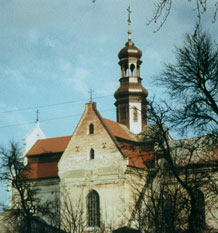
Figure 66(ii): The same church with new 'western' spire |
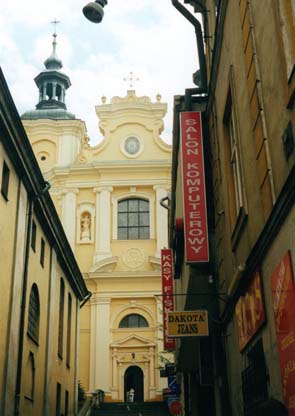
Figure 67: The Garrison church, now converted to serve as the Greek Catholic cathedral
Perhaps this discussion of a conflict over ecclesiastical property is enough for you to understand how religion and nationalism have come together in unpleasant combinations in post-communist Przemysl. The objective history of centuries of peaceful multicultural coexistence counts for nothing when people on all sides recall only a recent history of suffering and trauma. This subjective history is the one that shapes the present. The fact that we have thousands of Ukrainians flooding into the city's bazar every week has not made it any easier for local Poles to accept the presence of a Greek Catholic, Ukrainian minority within the city. There is a tendency to identify all Ukrainians with the dirt and sometimes dubious dealing techniques found on the marketplaces, and little appreciation that Ukraine can lay claim to a distinguished cultural tradition. Just how hard it is to belong to the Ukrainian minority here was demonstrated a few years ago when the Warsaw authorities decided that Przemysl was the ideal location for an Ukrainian Cultural Festival. This plan was rejected by the local council, which in practice has been under the control of nationalists. Eventually the Festival went ahead in conditions of high security and it was lucky that no one was injured when the Ukrainian Club was subject to an arson attack.'
In answer to a question from Tom, the speaker said that he himself was an
ethnic Pole, but one who was viewed with suspicion by many Poles in the city
simply because he sought good relations with leaders of the Ukrainian minority.
He was the head of a small research institute which specialised in the complex
inter-ethnic relations of the region, but for years he had been denied funds
and support in the city. His own institute had been attacked. Tom, who wondered
why he had never come across this institute on previous visits to his relatives,
asked if there was intermarriage between majority and minority in the new conditions.
'There is some, of course,' came the reply. 'But there is also a very strong
preference within the minority to marry one from their own group. It is especially
interesting to see how they view the religious divisions. The Greek Catholics
say that they would much prefer their children to marry someone from an Orthodox
family than to marry a Roman Catholic. They know that, in some theological sense,
they are closer to Roman Catholics. But what counts for them is not the theology
but the practice, and of course the Orthodox rituals are almost identical to
those of the Greek Catholics, and they speak the same Ukrainian language. And
they are aghast at the idea of introducing the Polish language into Greek Catholic
services, since they see this Church as central to the continued maintenance
of their Ukrainian identity.'
| Return to main page |